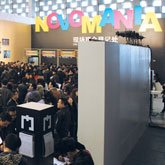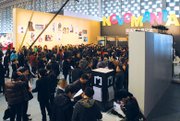U.S., European and Asian Brands Vie for Chinese Business at Novomania
SHANGHAI—Doing business in China requires an understanding of the Chinese market as well as branding and real estate expertise.
The recent edition of the Novomania trade show, which ran March 7–9 at the Shanghai World Expo Exhibition and Convention Center, showcased more than 100 brands from Europe, the United States and Asia. Unlike at a Western trade show, brands at Novomania presented fashion retail concepts in order to develop partnerships with distributors, franchisers and shopping malls.
While retail business in the United States and around the world is built on the idea of multi-brand stores, business in China is currently focused on mono-brands and real estate opportunities. Novo Group, organizers of the trade show, created the platform to help brands successfully enter the growing Chinese market, according to General Manager Guilherme Faria. “The whole idea of Novomania is to create the platform for the brands to manage to come to China in a bright way—in a way that they know what to expect and what’s to come next and there’s someone who is doing [a] filter of the brands,” he explained. “Everyone is opening their eyes to new markets. I think there is an actual need of the companies to expand to China, and they just don’t know how.”
Nearly 13,000 visitors attended the third edition of the show, which included a range of denim, sport and streetwear, contemporary clothing, shoes, and accessories, as well as a special section representing real estate developers. Exhibitors included Miss Sixty, Evisu, WeSC, DKNY Jeans, Calvin Klein Jeans, Tom Tailor, American Vintage, Desigual, Fly London, Insight51, Lee Cooper, Liebeskind, Odd Molly, Katharine Hamnett London, Supremebeing and Denim is Dead, as well as California-based DC Shoes, Hoodiebuddie, Nixon and Oakley. Novomania offered fashion shows to showcase brands and partnered with Savills, a leading global real estate services group, to offer seminars to help attendees understand current trends in the developing Chinese property market.
Currently, the show consists of an edited selection of brands—about half of which are already doing business in China, with the rest looking to enter China.
For brands attending, Novomania offers the opportunity to discover the various business models available and to connect with potential partners in China. “This is their first step to the market. They are coming here to understand the market, to showcase their product to the Chinese market. They are going to walk out of here with a lot of contacts. From there they can understand which [business] model is the correct one,” Faria said, explaining that there are a variety of ways to do business in China, including finding a distributor, joint ventures and licensing or coming directly as a foreign-owned entity in China.
“Novomania also allows the brands to understand exactly what’s the next step,” he added.
China is the second-largest apparel market in the world, after the United States. In the next few years, rising income levels and urbanization, combined with more disposable income for the middle class, will drive double-digit growth in apparel spending. With the market growing, many U.S. and European brands are racing to create a brand presence in China and a brand awareness with the increasingly fashion- and tech-savvy Chinese shopper. There are 512 million Chinese citizens born after 1980. This youth market is drawn to products that express their individuality—in essence, brands.
In order to be successful, brands are reaching out to these consumers through marketing, advertising, events, celebrity associations, and social-media, such as Weibo, the Chinese version of Facebook, Faria explained. “You have to show off your brand because otherwise, the competition is going to basically overlap you, and you’re going to disappear,” he said.
Brand building in a new market
The market is attractive to many, including Itochu, the Asian trademark owner of Katharine Hamnett London. Itochu’s Hiroto Misawa attended the show for the first time, looking for the right Chinese partner to control distribution and retail growth in China. The company has adapted the brand for the Japanese market with style and fit, so now it is seeking strong partners to open stores in China and Southeast Asia.
According to Misawa, the company is aiming for the middle of the market and the consumer who falls between luxury and casual. Others, such as Italian label Toy G, are strategizing on ways to enter the market and brand their image by using techniques such as personal shopping services to build clientele. “You don’t have to change the identity of your brand, but you have to adapt a little bit,” Faria said.
Brand awareness is key for the Chinese, said Jean-Baptiste Mazzoleni, co-owner of 101 Distribution, the China-based distributor for underwear brand Pull-In. “When they can identify the brand, it works. Sometimes it takes time for the brand to be easily identified,” he explained.
China’s rapidly growing retail market gives Chinese consumers a lot of choices. “They see a lot of product everyday, so they are getting pickier for the brands,” Mazzoleni said. “You have to introduce them to the brands.” Pull- In has been successful because the French brand’s colorful graphic underwear stands out. “What they like is [something] different. Because we are the only ones doing what we do—meaning colorful, punchy, something new—it’s an alternative. You have your basic underwear, but with Pull-In you have nice fabric and you have punchy designs.”
For Zeming Liu, owner of nearly 5-year-old Chinese denim label Able Jeans, attending Novomania was another step to help build his already successful brand. One of the top denim brands in China, Able Jeans is known for its innovative products and signature easyto- wear, modern vintage look. With 100 doors already open, the brand is taking a strategic approach to opening more doors across China.
Shopping malls and franchisers were attracted to the strong visual presentation and product presented. “We are trying to create something like [an] international image, a young lifestyle,” Liu said. “Not only Chinese, also foreigners— everybody can feel with the clothing, with the jeans, that they can be themselves.” The look appeals to the “modern Chinese” consumer, Liu explained. “They are the young people with a young mentality, with international eyes, with passion, with self-confidence. Now more and more Chinese young people have their own [identity]; they have their own personality. They want to be themselves. So this is our target.”
Real estate opportunities
Even successful international brands with many accounts are not guaranteed success in China, Faria said. “It’s a different market. It’s a retail-driven market. The first thing [needed] from the U.S., which is a very much wholesale and multi-brandoriented market, is to adapt and create these retail concepts,” he said. “Brands develop through franchise and expansion.”
Novo Group, founded in 2003, has three segments—Novo Concept, Novo Retail and Novomania, which launched in 2010 in response to requests from Novo clients. With its real estate and retail-industry connections, Novo Group has more than 700 points of sales in over 45 cities, where it works with more than 150 international brands. Due to the strength of these connections, Novomania has developed to include domestic and international brands with visitors including distributors, shopping malls and department stores from China and other parts of the Far East.
According to Novomania, a significant number of shoppingmall developments are planned to open across China over the next five years. Developers are looking for anchor tenants to differentiate themselves and for ways to attract urban-youth traffic. According to Faria, developing business in China requires a strong commitment and is a step-by-step process. “It’s all through a network of meeting more and more potential partners [and] go deeper in the tier of the cities and open more stores,” he said. “You have extremely successful brands from the U.S. here. The other ones can also be, but they have to shift the paradigm to adjust to the Chinese market.”























